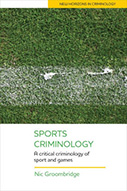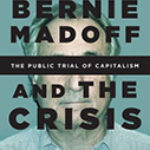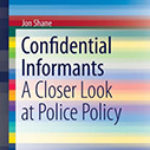Sports Criminology: A Critical Criminology Of Sport And Games

Author: Groombridge, Nic
Publisher: Bristol, UK: Policy Press, 2017.
Reviewer: Justin Kurland | May 2018
Is it about sport? Is it about criminology? Groombridge’s aptly titled book ‘Sports Criminology’ is an attempt to marry various theoretical paradigms from across the criminological spectrum to diverse aspects of sport. Each of the eight chapters illustrates not only intimate knowledge of countless criminological theories and perspectives, but also a masterful understanding of how they can be applied to better understand a vast number of historical and contemporary sport-related problems and crime.
The introductory chapter sets a tone by defining sport criminology for readers while usefully parrying more narrowly scoped, but related research areas such sport-related crime (SRC). Further, it provides an initial glimpse at the the style adopted throughout that weaves together intricate concepts and ideas from sociology, criminology and law to better contextualize everything from the interface between sport and politics to the on and off the field deviance and criminality associated with sport celebrities. The second chapter is a focused, critical examination of the criminological history of sports (and games) in everything from field and blood sports such as fox hunting and cockfighting to boxing, and even pinball. This is followed by a series of captivating case studies on sports scandals. The deliberate throwing of games to facilitate preferred outcomes in Olympic badminton, financially incentivizing NFL players to intentionally injure opponents, and the use of fake blood to take advantage of substitution rules in rugby union are just a few of the scandals addressed through the lens of criminological theories.
Chapters four and five switch gears and look inwards towards both criminological and sociological theories that have been used, or might be utilized in the future, to both understand sporting deviance and crime and also how they might be better controlled or prevented. More specifically, chapter four covers everything from routine activity theory and situational crime prevention to social control and labeling theory, while the latter wrestles with Marxism, feminist theories, and even green and rural criminology.
Chapter six tackles justice and social control in sport with an emphasis on the institutional bodies that govern it; pointed questions, again through the prism of criminological theory, are asked about how numerous issues have been handled and what might be gleaned from more traditional systems of criminal justice. In an interesting shift of gears chapter seven turns to the potential preventative effect of sport on crime, which is quite rightly accompanied by a healthy dose of skepticism given the dearth of empirical evidence to support the notion.
The final chapter begins with a summary of what was covered throughout and builds on this by suggesting new directions that sports criminology may take in the future. Groombridge ultimately closes by expressing some incredulity about what he may (or may not) have achieved in writing the book—and if it actually merits the title selected for it. Rest assured he has usefully synthesized criminology and sport, and it is should undoubtedly be the go to book for any criminologist interesting in diving into the arena (sports’ verb-related puns intended throughout)!
Justin Kurland, Senior Lecturer, New Zealand Institute for Security and Crime Science—University of Waikato.


